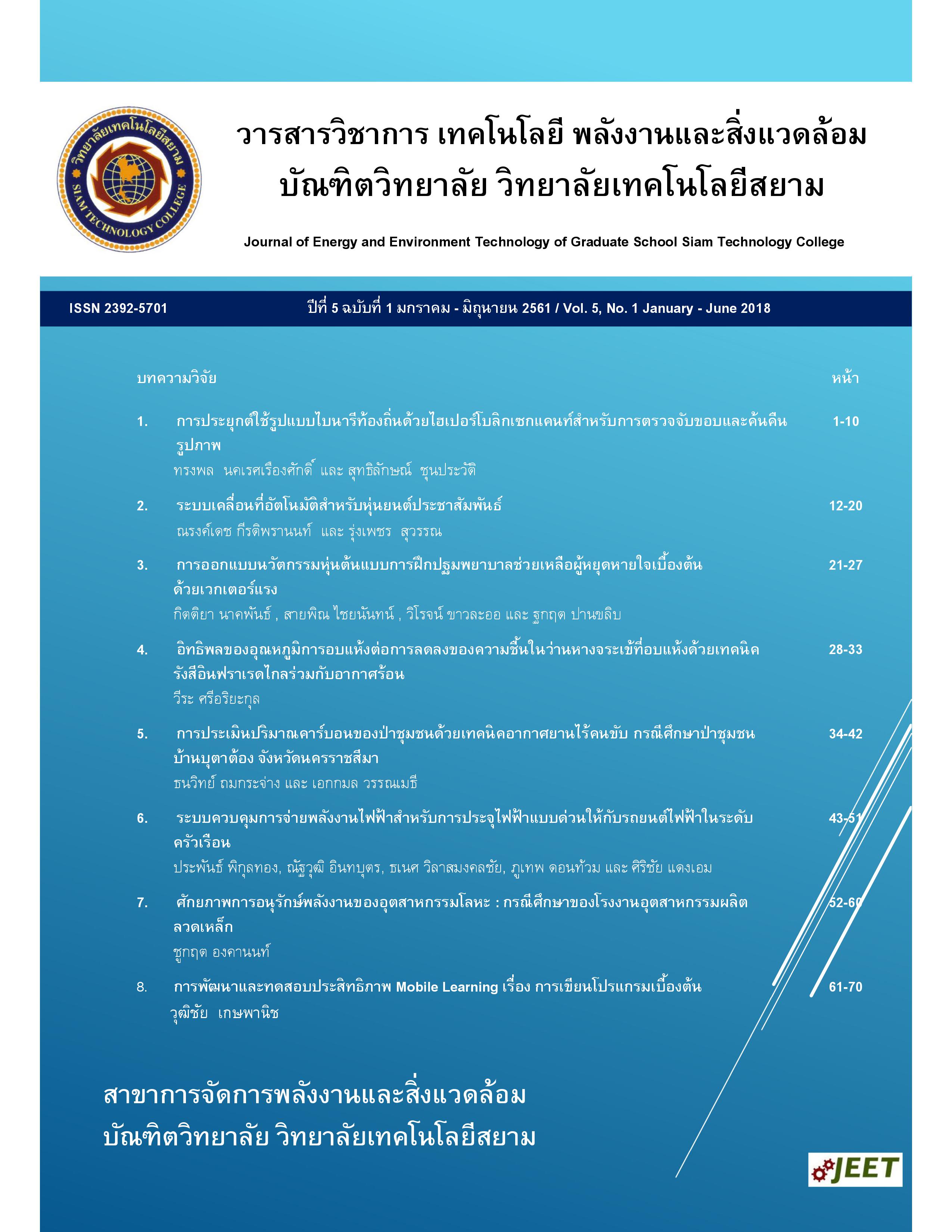Estimation of Carbon Sequestration in Community forests using Unmanned Aerial Vehicle (UAV) technique: A Case Study of Ban Bu Ta Tong Community forest, Nakornratchasima Province.
Main Article Content
Abstract
This study aims to estimate the amount of sequestrated carbon in the community forest at Ban Bu Ta Tong, Nakornratchasima province using Unmanned Aerial Vehicle technique (UVA). This technique obtained height of surface as point clouds, which were subsequently converted into Digital Surface Model (DSM) and Digital Terrain Model (DEM). Height of individual trees are derived by subtracting DSM and DEM over tree crown identified by visual interpretation. We also conducted field measurement of Individual tree heights (H) and diameter at the breath height of trees (DBH) in 10 plots of 40 * 40 meters for accuracy assessment of data obtained by UAV technique. Relations between H and DBH were formulated and used to estimate biomass and carbon amount of individual trees in the plots though allometric equations of deciduous dipterocarp forest type. The results show that height of trees derived by UAV techniques are strongly correlated to the field data (r2 between 0.715 –0.898). Average errors in tree height range between -0.025 to 0.07 meters among plots. The amount of carbon storage for all individual trees in the plots estimated using UAV data is different from those estimated using field data in a range of 13%-59%. These discrepancies can be explained by errors in estimating DBH given H from UAV since there is no clear relation between H and DBH in the plots. The amount of carbon for the entire forest is about 1827 tons or 9.13 tons per rai. This study may be used as a prototype in carbon estimation using UAV that can be further applied to forests in other areas with more complex tree structure.
Article Details
เนื้อหาและข่อมูลในบทความที่ลงตีพิมพ์ในวารสารวิชาการ เทคโนโลยี พลังงาน และสิ่งแวดล้อม บัณฑิตวิทยาลัย วิทยาลัยเทคโนโลยีสยาม ถือเป็นข้อคิดเห็นและความรับผิดชอบของผู้เขียนบทความโดยตรง ซึ่งกองบรรณาธิการวารสารไม่จำเป็นต้องเห็นด้วย หรือว่าร่วมรับผิดชอบใด ๆ
บทความ ข้อมูล เนื้อหา รูปภาพ ฯลฯ ที่ได้รับการตีพิมพ์ในวารสารวิชาการ เทคโนโลยี พลังงาน และสิ่งแวดล้อม บัณฑิตวิทยาลัย วิทยาลัยเทคโนโลยีสยาม ถือเป็นลิขสิทธิ์ของวารสารวิชาการ เทคโนโลยี พลังงาน และสิ่งแวดล้อม บัณฑิตวิทยาลัย วิทยาลัยเทคโนโลยีสยาม หากบุคคล หรือหน่วยงานใดต้องการนำทั้งหมด หรือส่วนหนึ่งส่วนใดไปเผยแพร่ต่อ หรือเพื่อกระทำการใด ๆ จะต้องได้รับอนุญาต เป็นลายลักษณ์อักษรจากวารสารวิชาการ เทคโนโลยี พลังงาน และสิ่งแวดล้อม บัณฑิตวิทยาลัย วิทยาลัยเทคโนโลยีสยาม เท่านั้น
References
[2] ชิงชัย วิริยะบัญชา (2546). คู่มือการประเมินมวลชีวภาพของหมู่ไม้, กรุงเทพฯ: ฝ่ายวนวัฒนวิจัยและพฤกษศาสตร์ กรมอุทยานแห่งชาติ สัตว์ป่า และพันธุ์พืช
[3] กรมป่าไม้. บุตาต้อง. (2560). ทะเบียนป่าชุมชน, [ระบบออนไลน์], แหล่งที่มาhttp://forestinfo.forest.go.th/fCom_detail.aspx?id=8998, เข้าดูเมื่อวันที่ 02/09/2017.
[4] ASPRS. AMERICAN SOCIETY FOR PHOTOGRAMMETRY AND REMOTE SENSING. ASPRS accuracy standards for large-scale maps. Photogrammetric Engineering & Remote Sensing, 1078-1080, 1990.
[5] องค์การบริหารจัดการก๊าซเรือนกระจก (องค์กรมหาชน) (2558). สาขาป่าไม้และการเกษตร, กรุงเทพฯ: การพัฒนาโครงการลดก๊าซเรือนกระจกภาคสมัครใจตามมาตรฐานของประเทศไทย
[6] Ogawa, H., Yoda, K., Ogino, K. & Kira, T. (1965). Comparative Ecological Studies on Three Main Type of Forest Vegetation in Thailand II. Plant Biomass, Nature and Life in Southeast Asia Vol 4, pp.49-80.


